The Ship-Submarine Recycling Program (SRP) is the process that the United States Navy uses to dispose of decommissioned nuclear vessels. SRP takes place only at the Puget Sound Naval Shipyard (PSNS) in Bremerton, Washington, but the preparations can begin elsewhere.
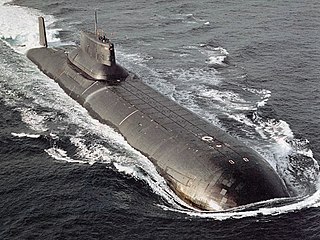
The Project 941 Akula, was a class of nuclear-powered ballistic missile submarines designed and built by the Soviet Union for the Soviet Navy. With a submerged displacement of 48,000 t, the Typhoons were the largest submarines ever built, able to accommodate comfortable living facilities for the crew of 160 when submerged for several months. The source of the NATO reporting name remains unclear, although it is often claimed to be related to the use of the word "typhoon" ("тайфун") by General Secretary Leonid Brezhnev of the Communist Party in a 1974 speech while describing a new type of nuclear ballistic missile submarine, as a reaction to the United States Navy's new Ohio-class submarine.
The November class, Soviet designation Project 627 Kit was the Soviet Union's first class of nuclear-powered attack submarines, which were in service from 1958 through 1990. All but one have been disposed of, with the K-3, the first nuclear-powered submarine built for the Soviet Navy, being preserved as a memorial ship in Saint Petersburg.

The Victor class, Soviet designations Project 671 Yorsh, Project 671RT Syomga and Project 671RTM/RTMK Shchuka,, are series of nuclear-powered attack submarines built in the Soviet Union and operated by the Soviet Navy. Since the 1960s, 48 units were built in total, of which the last remaining are currently in service with the Russian Navy. The Victor-class submarines featured a teardrop shape, allowing them to travel at high speed. These vessels were primarily designed to protect Soviet surface fleets and to attack American ballistic missile submarines. Project 671 began in 1959 with the design task assigned to SKB-143.

USS Grayling (SSN-646), a Sturgeon-class attack submarine, was the fifth ship of the United States Navy to be named for the grayling. Her keel was laid down in 1964, and she was launched just over three years later, and commissioned in 1969. She was involved in the submarine incident off Kola Peninsula on 20 March 1993, when she collided with the Russian Navy submarine Novomoskovsk. She was decommissioned in 1997, and disposed of a year later.
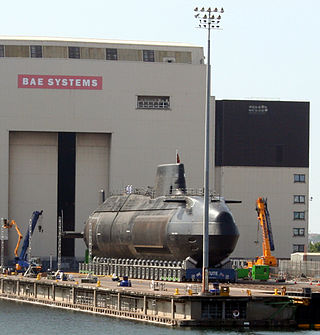
A nuclear submarine is a submarine powered by a nuclear reactor, but not necessarily nuclear-armed. In the US classification, nuclear-powered submarines are designated as SSxN, where the SS denotes submarine, x=G means that the submarine is equipped with guided missiles, x=B means that the submarine is equipped with ballistic missiles and the N means that the submarine is nuclear-powered. SSN refers to nuclear-powered attack submarines, which do not carry missiles.

The Akula class, Soviet designation Project 971 Shchuka-B is a series of fourth generation nuclear-powered attack submarines (SSNs) first deployed by the Soviet Navy in 1986. There are four sub-classes or flights of Shchuka-B, consisting of the original seven Project 971 boats, commissioned between 1984 and 1990; six Project 971Is, commissioned between 1991 and 2009; one Project 971U, commissioned in 1995; and one Project 971M, commissioned in 2001. The Russians call all of the submarines Shchuka-B, regardless of modifications.

К-3 was a project 627 "Кит" submarine of the Soviet Navy's Northern Fleet, the first nuclear submarine of the Soviet Union. The vessel was prototyped in wood, with each of five segments scattered between five different locations about Leningrad, including the Astoria Hotel. She was built in Molotovsk, launched on 9 August 1957, commissioned in July 1958, and homeported at Zapadnaya Litsa on the Kola Peninsula. K-3 was designed by Vladimir Peregoudov. Her initial captain was Leonid Osipenko, and the executive officer was Lev Zhiltsov, who had the important task of assembling the first crew.
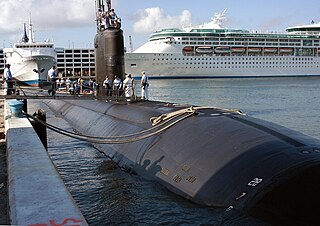
USS Miami (SSN-755) was a Los Angeles-class submarine of the United States Navy. She was the third vessel of the U.S. Navy to be named after Miami, Florida. Miami was the forty-fourth Los Angeles-class (688) submarine and the fifth Improved Los Angeles-class (688I) submarine to be built and commissioned. The contract to build her was awarded to the Electric Boat division of General Dynamics Corporation in Groton, Connecticut, on 28 November 1983, and her keel was laid down on 24 October 1986. She was launched on 12 November 1988 and commissioned on 30 June 1990 with Commander Thomas W. Mader in command.
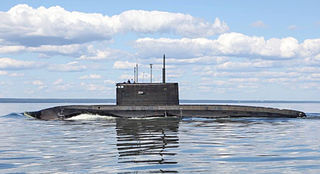
The Kilo-class submarines are a group of diesel-electric attack submarines designed by the Rubin Design Bureau in the Soviet Union in the 1970s and built originally for the Soviet Navy.

An SSN is a nuclear-powered general-purpose attack submarine. SSN is the US Navy hull classification symbol for such vessels; the SS denotes a submarine and the N denotes nuclear power. The designation SSN is used for interoperability throughout NATO under STANAG 1166, though navies use other terms.

The Morzh-class submarines were built for the Black Sea Fleet of the Imperial Russian Navy shortly before World War I.
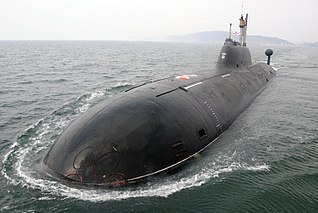
Nerpa is a 8,140-tonne (8,010-long-ton) Project 971 nuclear-powered attack submarine. The construction of the submarine was started in Russia in 1993, but was suspended due to lack of funding. India then sponsored further construction and sea trials of the submarine provided it was leased to the Indian Navy for 10 years. It was launched as K-152 Nerpa in October 2008 and entered service with the Russian Navy in late 2009. The submarine was leased to the Indian Navy in 2011 after extensive trials, and was formally commissioned into service as INS Chakra with the Eastern Naval Command at a ceremony in Visakhapatnam on 4 April 2012. In June 2021 Chakra was spotted on the surface escorted by Indian and Russian warships in the Singapore Strait while presumably heading towards the Russian naval base in Vladivostok; some media speculated that she was returning to Russia before the expiry of the lease term.

The K-152 Nerpa accident occurred aboard the Russian submarine K-152 Nerpa on 8 November 2008, which resulted in the deaths of 20 people and injuries to 41 more. The accident was blamed on a crew member who was allegedly playing with a fire suppressant system that he thought was not operative.

The submarine incident off Kildin Island was a collision between the US Navy nuclear submarine USS Baton Rouge and the Russian Navy nuclear submarine B-276 Kostroma near the Russian naval base of Severomorsk on 11 February 1992. The incident occurred while the US unit was engaged in a covert mission, apparently aimed at intercepting Russian military communications. Although most sources claim that the American submarine was trailing her Russian counterpart, some authors believe that neither Kostroma nor Baton Rouge had been able to locate each other before the collision.
The decommissioning of Russian nuclear-powered vessels is an issue of major concern to the United States and to Scandinavian countries near Russia. From 1950 to 2003, the Soviet Union and its major successor state, Russia, constructed the largest nuclear-powered navy in the world, with more ships than all other navies combined: 248 submarines, four Kirov-class battlecruisers, and a missile test ship, as well as nine icebreakers. Many were or are powered by two reactors each, bringing the total to 468 reactors.
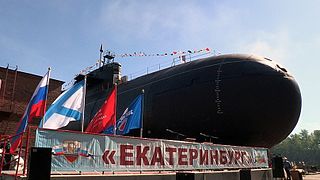
K-84 Ekaterinburg is a Project 667BDRM Delfin-class nuclear-powered ballistic missile submarine. The submarine was laid down on 17 February 1982 at the Russian Northern Machine-Building Enterprise (Sevmash). It was commissioned into the Soviet Navy on 30 December 1985. After the collapse of the Soviet Union, the submarine continued to serve in the Russian Navy. Initially known only by its hull number, in February 1999 it was renamed after the city of Yekaterinburg.

The Russian submarine Nerpa was the second boat of the Morzh class of submarines of the Imperial Russian Navy. It was laid down and launched on the same day in August 1913, and completed its sea trials in December 1914. Built for the Black Sea Fleet, the submarine saw action during World War I, and spent much of the war raiding Ottoman merchant shipping that transported coal from Zonguldak to Constantinople. Nerpa was credited with sinking 24 ships during the conflict for a total of 2,443 gross register tons (GRT), making it the fourth most successful Russian submarine in the Black Sea.














